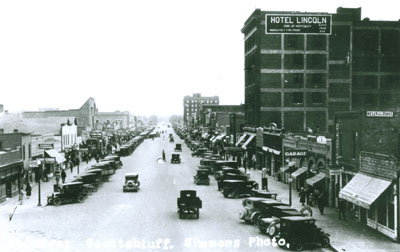Last updated: October 26, 2020
Article
Exploring America: Online Travel Itineraries and the Scotts Bluff Region

Photo courtesy of North Platte Valley Museum Archives.
Currently, the Discover Our Shared Heritage Series boasts more than 45 diverse itineraries, with new additions made frequently. Most itineraries consist of conceptual essays and site descriptions that explain the importance of the historic sites in American history. The itineraries also provide maps, historic and modern photographs of sites, and tourism information. The series is easy to access and navigate, well researched, and is an indispensible tool for anyone wishing to learn more about a National Register site. From school projects to family vacations, anyone can log on and spend hours reading about a particular theme, place, or region.
Within the Midwest Region of the NPS, there are currently six itineraries that focus on national historical themes. They encompass a wide range of topics such as the lives of American Presidents and important sites within the modern Civil Rights movement. The Midwest Region has nine regional itineraries, of which Pierre and Fort Pierre in South Dakota and the Scotts Bluff Region in western Nebraska are the most recent additions.
Completed in the summer of 2009, the Scotts Bluff Region travel itinerary explores a broad segment of American history—the earliest days of emigrant travel to the West, cattle ranching and homesteading, the implementation of irrigated crop cultivation, and the growth of modern cities. Due to the diversity of the National Register sites highlighted in the itinerary, the Scotts Bluff selection offers users an exploration of sites both urban and rural, geologic and manmade, historic and modern. The itinerary was created for the NPS Midwest Regional Office by National Council for Preservation Education (NCPE) interns Mark Fluehr and Cody Hackett.
Scotts Bluff is significant in the history of the American West. Throughout the 19th century, tens of thousands of American emigrants trekked west across the American continent in search of homesteads, gold, or religious freedom, and Scotts Bluff was an important geographic landmark on the trail. The first leg of the Overland Trail went across the Great Plains, following the Platte River Valley. Often a resting point for weary overland travelers, the 800-foot-tall Scotts Bluff signaled the end of the first third of the emigrant journey and marked the beginning of more difficult travel through the unforgiving Rocky Mountain terrain.
During the latter half of the 19th century, as railroads replaced wagon trains, cattle ranchers and homesteaders began to populate the Scotts Bluff region. Pioneering in the Nebraska Panhandle was difficult. Harsh winters, sandy soils, and scarce water reserves could bankrupt even the most successful cattlemen or farmers. Because of these and other difficulties, it was not until farmers began implementing irrigated farming and scientific agriculture in the late 19th and early 20th centuries that the area’s population began to grow substantially. As the region grew in population and farm production, railroad companies, eager to tap the budding passenger and freight market, began laying direct rail lines into the region. The first half of the 20th century was an economic boom period. The area’s two major cities, Gering and Scottsbluff, grew from sleepy regional trading centers into a single, large urban center of trade and commerce, complete with a luxury hotel, opera house, and movie theater. Even today, Gering and Scottsbluff remain the economic hub of western Nebraska.
The History and National Register Programs staff at the NPS Midwest Regional Office invites you to visit Scotts Bluff, or any of the online travel itineraries by visiting: https://www.nps.gov/subjects/heritagetravel/discover-our-shared-heritage.htm.
We would like to thank the following for their contributions to the Scotts Bluff Region Travel Itinerary:
Stephen Rogers, Architectural Historian, Scotts Bluff Travel Itinerary Project Supervisor
Barbara Netherland, North Platte Valley Museum
Nancy Haney and Jack Preston, Farm and Ranch Museum
Ken Mabery, Scotts Bluff National Monument
Kevin Howard, Scottsbluff County Tourism
National Register Itinerary Advisory Group, Scottsbluff
Nebraska State Historic Preservation Office
Nebraska Department of Economic Development, www.visitnebraska.gov
Originally published in "Exceptional Places" Vol. 4, 2009, a newsletter of the Division of Cultural Resources, Midwest Region. Written by Cody Hackett and Mark Fluehr.
